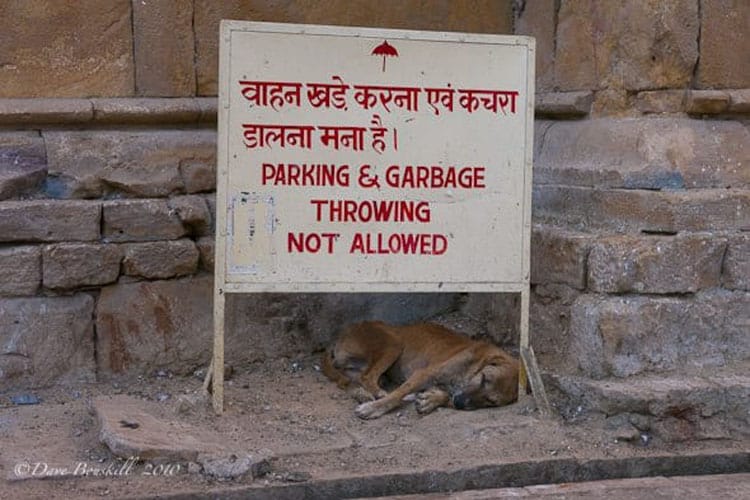1. India is a Contradiction
2. Exploring the South Versus the North
3. The Deteriorating Conditions in Rajasthan
4. The Government’s Role in Cleanliness
A couple of weeks ago, I posted about India’s cleanliness, which was much better than anticipated. However, shortly after sharing this article, I’ve had to reconsider my viewpoint.
Since that day, we have observed a gradual decline in cleanliness throughout India. Our journey began in the South, where we had heard numerous tales of garbage, cow dung, and pollution.
India is Filthy
The South is Cleaner than the North
Update 2021 – Comments have been disabled for this post. This post was originally written in 2010.
Goa offered a pleasant surprise with dedicated beach clean-up efforts every morning (except for the unfortunate cow carcass that attracted dogs). Observing garbage trucks on occasion was also refreshing.
Although Hampi may have appeared somewhat rough, it was still manageable without excessive discomfort. On the other hand, Kerala seemed quite pristine, and as for Mumbai, I would genuinely enjoy revisiting that city.
The city featured a few sidewalks, trash cans sporadically placed, and a waterfront path that allowed for an escape from the congested traffic. Notably, we didn’t encounter cows in Colaba or the Fort District.
In retrospect, starting our journey in the south may not have been the best decision.
If we had begun our travels in the opposite direction, we might have observed India improving in cleanliness as we progressed. Although these changes could only be incremental, each city would have likely presented some positive developments.
Instead, with each stop, we witness an increasingly unsanitary environment. We find ourselves so disturbed in the North that after visiting Varanasi and the Ranthambore tiger sanctuary, we might consider escaping while we still hold fond memories of India.
Rajasthan has been noticeably a mess.
Udaipur, our first destination, charmed us despite the presence of cow dung and litter on the streets. Despite its challenges, the city exudes beauty, romance, and warmth from its inhabitants.
Nonetheless, the lake was notably polluted, and on occasion, the odor of urine from nearby walls was quite pungent, yet it was manageable.
As we traveled through Rajasthan, each new city presented greater challenges, with refuse abounding. Streets were increasingly cluttered with human waste alongside cow dung.
Additionally, open sewers lined the building foundations, making navigation difficult and the accumulating filth more pronounced with each passing day.
The Government Needs to Do Something
Now that we find ourselves in Rajasthan, it is disheartening to ponder why local authorities are not taking action. Living amidst such waste is unnecessary.
With a billion residents, it would seem feasible to employ people for regular clean-up initiatives. Implementing garbage receptacles could serve as a step in the right direction.
Moreover, utilizing individuals for community service as a punishment could also promote civic responsibility, similar to practices in Canada.
Dave and I observe this cleanliness crisis daily, frequently remarking on the lack of reason behind the mess. However, engaging in conversation while walking is nearly impossible; I often find myself trailing behind as he navigates the streets.
Walking side by side is simply not feasible. We must often walk single-file along the road, contending with cars, rickshaws, and, of course, the persistent litter.
Walking in India is Hard Work
We have noted that navigating India is challenging for relationships, as we hardly get to hold hands or converse during our walks.
No, walking in India is laborious. I often cover my nose with a scarf to mitigate the unpleasant odors in the air.
Moreover, it requires constant attention to our steps to avoid accidental encounters with unpleasant hazards. One moment of distraction could lead to stepping into an unfortunate mess.
Perhaps local entrepreneurs should consider renting out hip waders to tourists; I suspect there would be considerable interest!
Throughout our journey, we must avoid buses, cars, rickshaws and dodge unexpected spits from passing vehicles. Occasional obstructions include homeless individuals or sleeping dogs, and cows remain unmovable, presenting further challenges from touts and beggars.
For a true adventure, simply attempt a leisurely stroll in India!
The temples in India are remarkable, and the forts are impressive; however, the presence of waste, feces, and garbage significantly detracts from the experience, prompting us to consider leaving the country temporarily.
What can I say? We’ve reached our threshold. The unpleasant sights and smells of excrement and rotting food in the streets are simply overwhelming.
This experience truly heightens our appreciation for the cleanliness we enjoy back in Canada—thanks in large part to our dedicated garbage collection services.
Those individuals certainly deserve all the recognition and compensation they receive!
Therefore, to the Indian government, which prides itself on being the world’s largest democracy, we implore you: prioritize the well-being of your citizens and take urgent action to clean up your streets!





